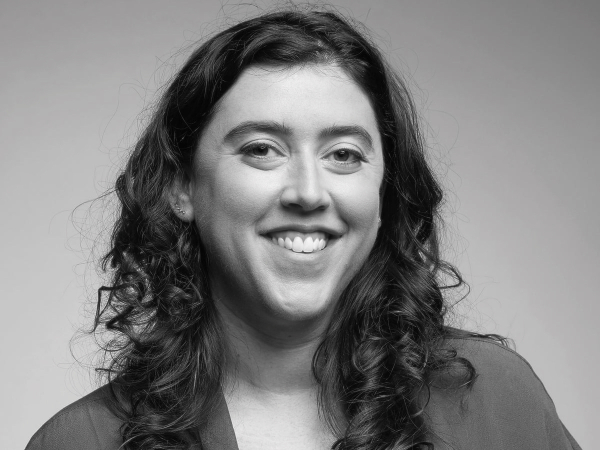State of Emergency. How do you document colonial abuses when archives have been destroyed?
Posted in: UncategorizedIn 1952, members of the Kikuyu tribe, known as the Mau Mau, began a guerrilla campaign against the regime of dispossession and violence in the British Kenya colony. In October that year, the Governor of Kenya Evelyn Baring declared a formal ‘state of emergency’. The policies implemented by colonial authorities were brutal. Men and women suspected of subversive activities were arrested and led to detention camps and “enclosed villages” where they were submitted to torture, mutilation, rape and dehumanising treatment.
In an effort to cover up their crimes, colonial officials destroyed documents before their departure from Kenya in 1963.

Members of the Mukurwe-ini Mau Mau War Veterans Association demonstrate how people were rounded up and sent to detention camps, Mukurwe-ini, Nyeri County, 2015
Photographer Max Pinckers collaborated with Mau Mau war veterans and Kenyans who survived colonial atrocities to give a visual existence to the fight for independence from British colonial rule in the 1950s. With most of the colonial archives deliberately destroyed, hidden or manipulated, they used reenactments, or “demonstrations,” to fill in the blind spots in British colonial history. The work also includes fragmentary colonial archives, photographs of architectural and symbolic remnants from the past (mass graves, execution sites, detention camps, trees that stand as memorials) and the testimonies of people who experienced and survived the war. Called State of Emergency – Harakati za Mau Mau kwa Haki, Usawa na Ardhi Yetu, the work is part documentary, part archive, part collective re-writing of history.
Seeing people demonstrate the violences they were submitted to or the strategies they developed to resist leaves a powerful mark on the imagination. Making images that were not supposed to exist also raises ethical concerns that Pinckers discussed with his collaborators. In one of the photos, Christopher Njaguera (b. 1943), aka Mathenge, demonstrates how Mau Mau detainees were castrated. “Dealing with traumatic pasts, sometimes it’s easier to physically show something than it is to literally explain what happened. I found it a moving way to make pictures, where people demonstrate things that happened to themselves, but 60 to 70 years earlier,” Pinckers explained.
I discovered State of Emergency while visiting EXPOSED, Turin’s new Photo Festival a couple of weeks (or rather months!) ago. Here’s a short selection of the material exhibited. With comments underneath some of the photos and videos:
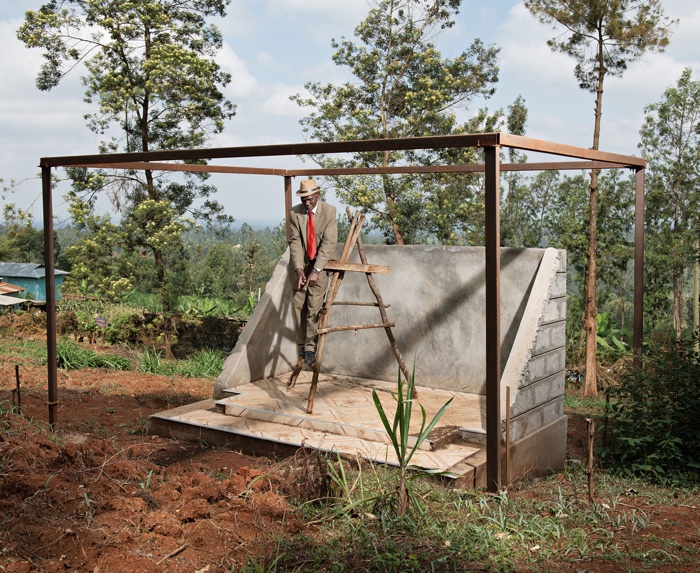
George Mburu wa Gitou (b. 1935) shows where convicted Mau Mau were hanged on the mobile gallows. A monument is erected in remembrance of the people who were executed there, Githunguri, 2019
Public hangings were outlawed in Britain for over a century but took place in Kenya during the Mau Mau revolt. A mobile gallows was transported by the British around the country to carry out the execution of Mau Mau suspects. Between 1952 and 1958, 1,090 Kikuyu were hanged. In no other place, and at no other time in the history of British imperialism, was state execution used on such a scale.
Excerpt from the BBC Correspondent documentary Kenya: White Terror, aired on November 17, 2002
Terence Gavaghan, MBE (1922–2011) was a British colonial district officer in Kenya responsible for six detention centers in Mwea during the emergency. He was the chief architect of the “dilution technique” and was known for implementing the systematic destruction of bodies and minds in Kenya’s detention camps.
During Operation Legacy, Gavaghan also participated in the burning of documents in incinerators and ensured that others would be permanently held under lock and key.
Extra’s on Death Row
Shot in Kenya at the height of the Mau Mau rebellion, Simba tells the story of a White settler family who find themselves involved in the uprising. Several of the Mau Mau extra’s were played by real Mau Mau rebels under death sentence. Prison authorities “brought them from their cages” to be filmed at the perimeter of the prison. Three of the eleven men filmed were executed three days later.
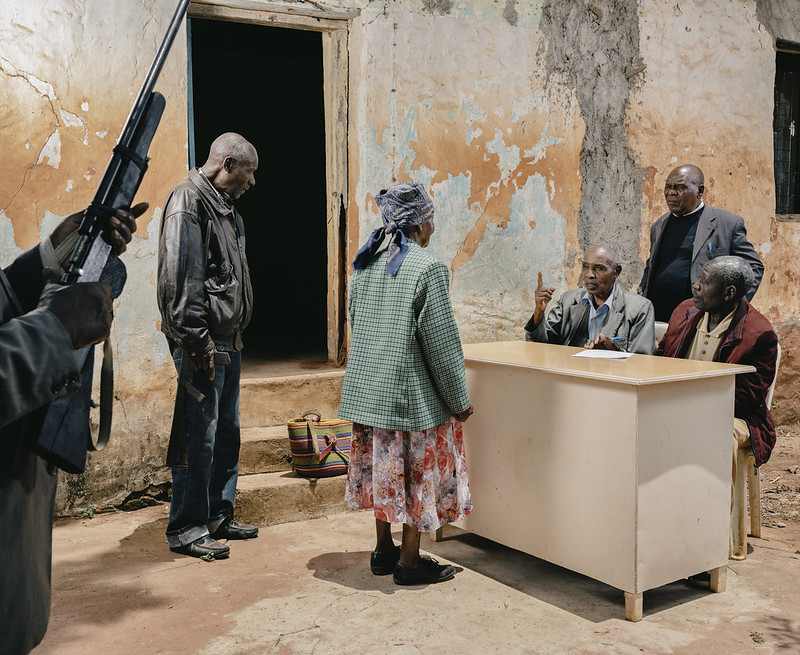
Beninah Wanjugu Kamujeru from MMWVA Murang’a demonstrates how she was interrogated. John Mwangi, Ndungu Ngondi (1939-2023), Joseph Gachina and Wilfred K. Maina (left to right) pretend to be the screening team. Murang’a, Kenya, 30 Agosti 2019
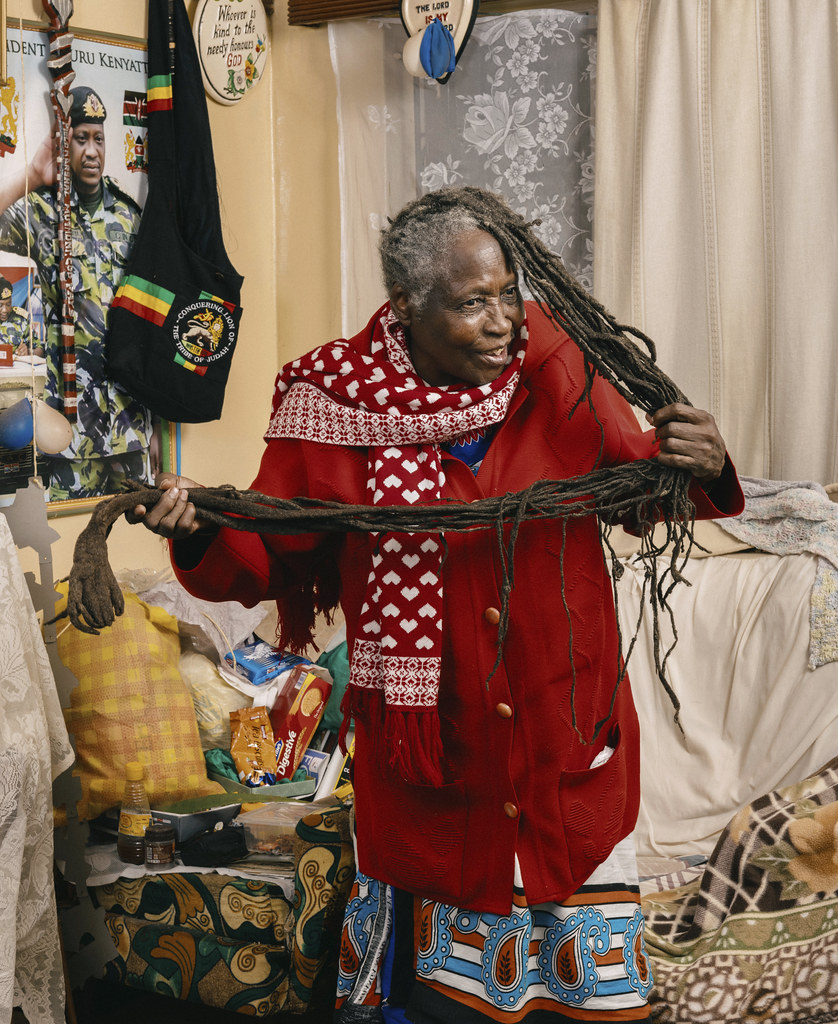
Field Marshal Muthoni wa Kirima, Nyeri, Kenya, 28 August 2019

Field Marshal Muthoni wa Kirima at her home with her grandson Bernard Mungai Kamande. Nyeri, Kenya, 28 August 2019
Field Marshall Muthoni wa Kirima was the highest ranking female Mau Mau forest fighter. At the time of making her portrait, Muthoni still had the same dreadlocks she had when fighting in the forest. She called them ‘the history of Kenya’. She vowed only to cut them when the deserved compensation was given to the Mau Mau veterans. The erasure of Muthoni and others like her from Kenya’s history books depresses her as she sites how unfortunate it is that “only white people” visit her inquiring about her story.
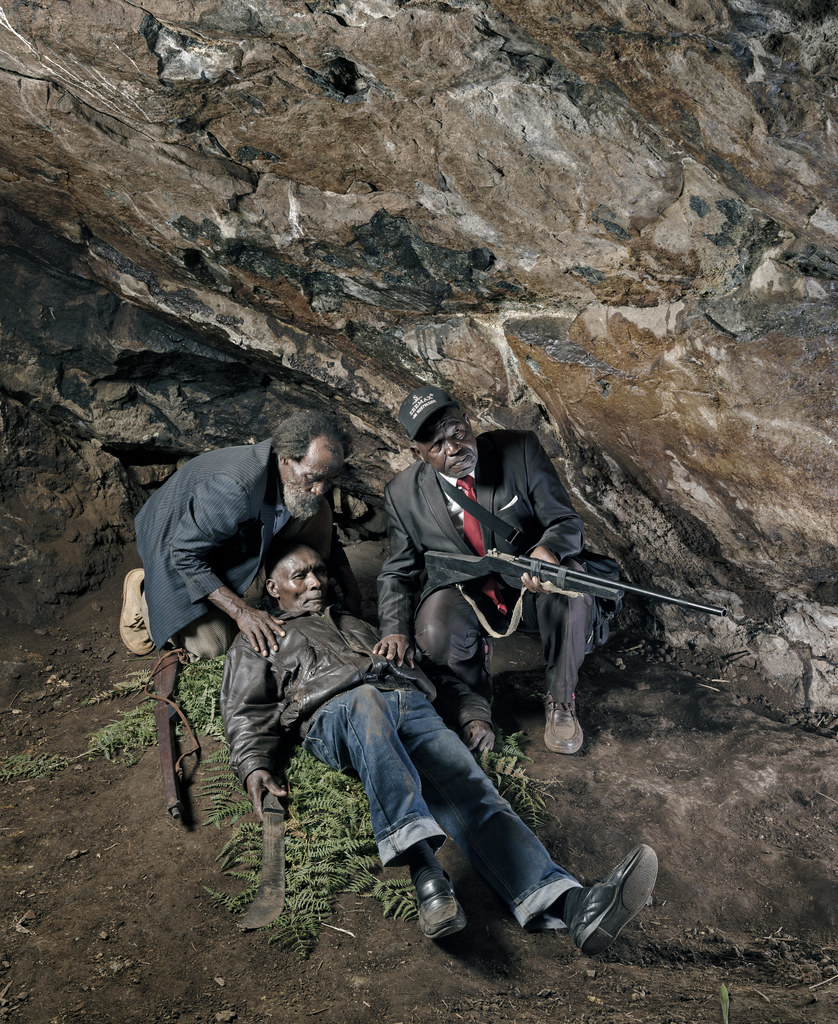
Peter Irungu Njuguna, John Mwangi and Paul Mwangi Mwenja (left to right) from the MMWVA Murang’a demonstrate how Mau Mau would treat a wounded soldier at a Mau Mau hideout in Gitoro Cave, Murang’a, Kenya, 29 August 2019
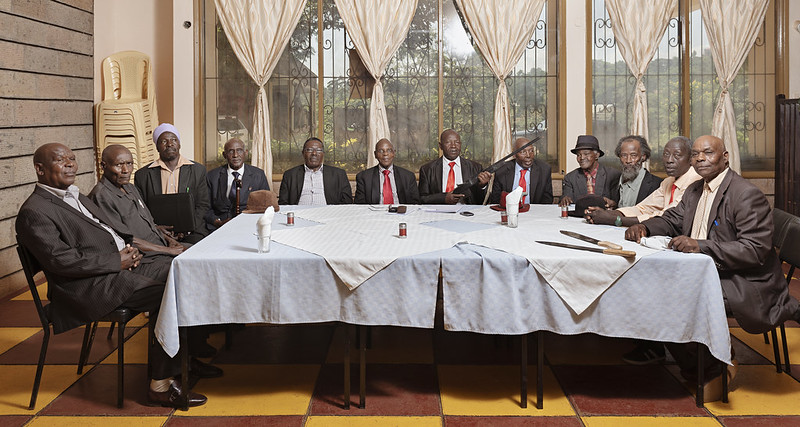
Members of the Mau Mau War Veterans Association, Murang’a Branch, Muranga’a, 2019. From left to right: Joseph Gachina, John Mwangi, John K. Mwangi, Johanna Kabuchu, Julius Gilbert Kimari, Peter G. Kamau (Chairman), Paul Mwangi Mwenja, Mwangi Wangai, Maina Njathi, Peter Irungu Njiuguna, Wilfred K. Maina, David Maina Kaya
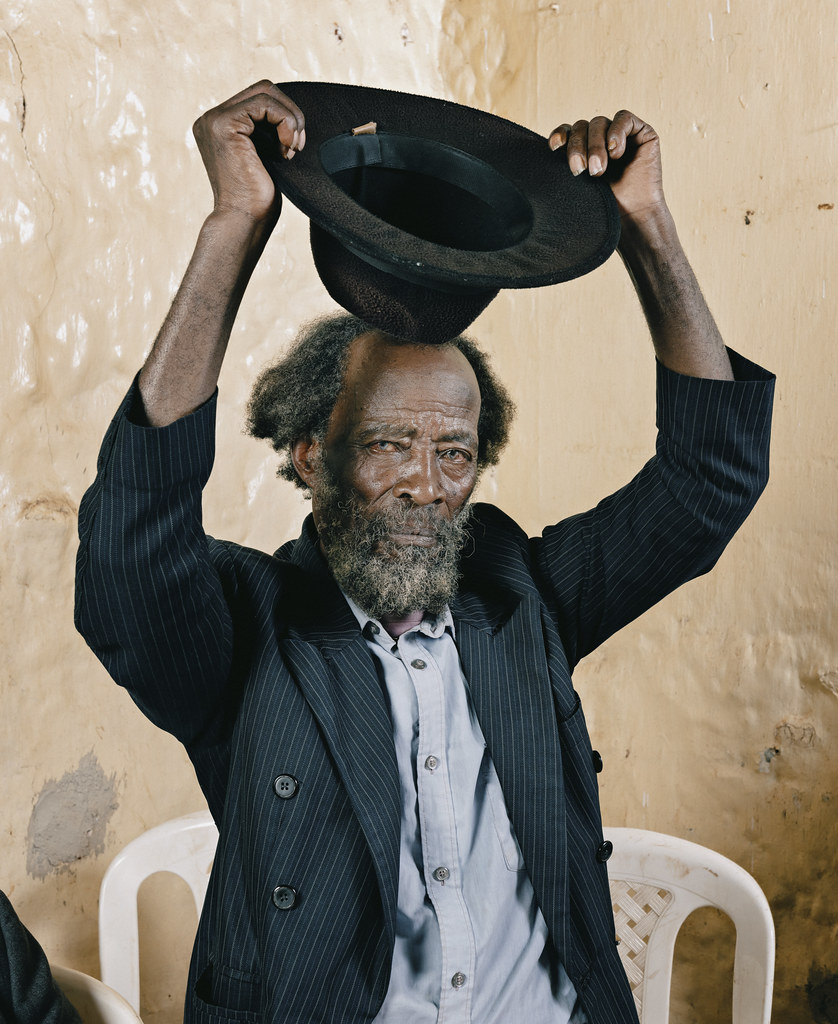
Peter Irungu Njuguna, MMWVA Murang’a, Kenya, 29 August 2019
A burning pile of documents that were found in a stock in the Nyeri County Archives in Kenya. These were duplicates of colonial-era documents held at the Nairobi National Archive, 2015

State of Emergency at Palazzo Madama. Installation view. Photo Nicola Morittu

State of Emergency at Palazzo Madama. Installation view. Photo Nicola Morittu

State of Emergency at Palazzo Madama. Installation view. Photo Nicola Morittu

State of Emergency at Palazzo Madama. Installation view. Photo Nicola Morittu
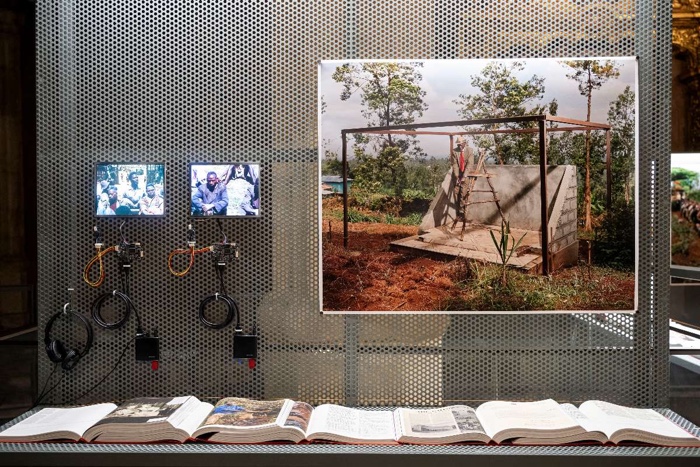
State of Emergency at Palazzo Madama. Installation view. Photo: Palazzo Madama
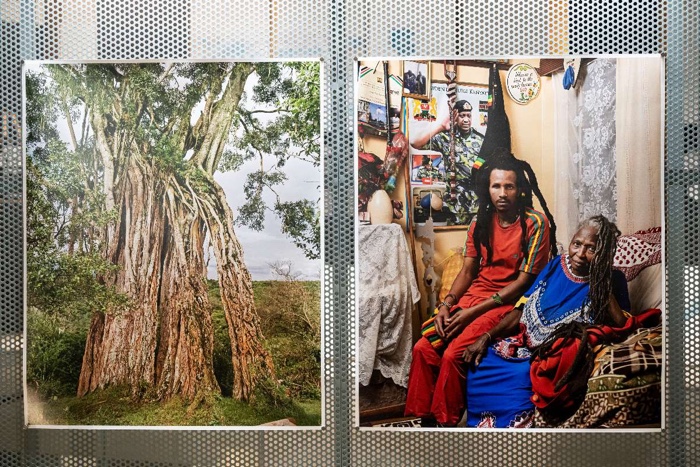
State of Emergency at Palazzo Madama. Installation view. Photo: Palazzo Madama
State of Emergency was curated by Salvatore Vitale. I discovered it during a visit of EXPOSED, Turin’s new Photo Festival. Also part of the festival: True Colors. Sabotaging the deceitful ecological narrative of the automotive industry.




